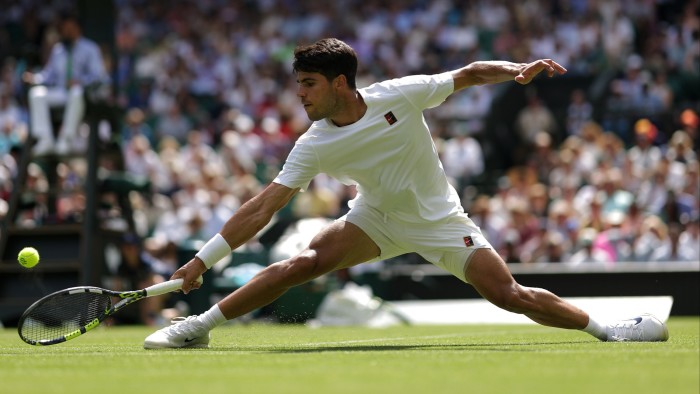Unlock the Editor’s Digest for free
Roula Khalaf, Editor of the FT, selects her favourite stories in this weekly newsletter.
The immaculate grass courts at the Wimbledon tennis championships can divide opinion. Some players struggle to find their rhythm on a surface that is unpredictable and unfamiliar. Others revel in it.
“I think the most beautiful tennis that we can watch is on grass,” said Carlos Alcaraz, the reigning men’s singles champion, on the eve of this year’s tournament. “The movement is really tough, but when you get it, it’s [like] you’re flying.”
Due to its short playing season and high maintenance costs, grass court tennis is under threat. Of the more than 60 events on the men’s professional tour, just seven are played on grass during a brief window that runs from the second week of June to the Wimbledon finals weekend in mid-July. Only in the UK and Australia is grass still a widely used playing surface.
For the All England Lawn Tennis Club, which runs the Wimbledon championships, the fate of grass court tennis is existential. The Grand Slam tournament’s identity is intrinsically linked to its lush green courts and the unique playing style. On grass, the ball typically moves faster and bounces lower, while players come closer to the net and deploy a wider variety of shots than on other surfaces.
“On grass, everything can really happen,” said Jasmine Paolini, last year’s losing Wimbledon finalist.
The club is now the guardian of grass court tennis globally, and works year-round to make it more sustainable and practical both at the elite and amateur level. It funds research aimed at lengthening the playing season — from trialling new strains of grass and soil mixes to developing new systems that add synthetic fibres to living turf to make it harder wearing.
At the Sports Turf Research Institute, a consultancy based in Yorkshire, scientists keep a watchful eye over 192 plots — each 1.5 square metres — where 63 different grass cultivars are tested for durability against the current mix used in SW19.
Each is mown, fed and watered the same way, then tested for wear and tear by a bespoke machine that uses rubber paddles to mimic the effects of players gliding across the baseline during a match. The findings are then shared with tennis clubs across the world.

The STRI also helps produce a catalogue containing 300 different varieties of turf, known in the industry as the “Dulux catalogue of grass”.
Sam Swire, the STRI’s head of research, says the challenges facing tennis come not just from hotter summers, which increase the risk of invasive weeds, but also from milder winters that leave grass courts more susceptible to fungal infections.
“The weather isn’t as predictable as it once was. So as much as you try to look ahead and use preventive maintenance techniques and things along those lines, it’s becoming much harder,” he said.


This year the 20-person team that maintains the playing surfaces at Wimbledon have had to contend with the driest spring on record, the hottest opening day of the tournament, then hours of rain on day three.
Yet Neil Stubley, the head of courts and horticulture at the championships, is unfazed by the changing weather. “This year, we’ve had very good grass growth going into the championships,” he said. “The data that we’re collecting at the moment is pretty much telling us that they are within the ranges that we would expect.”
Along with new grass strains that can cope with warmer weather, work is also going into developing hybrid courts that contain 5-10 per cent synthetic fibres. The addition of plastic to living turf makes the surface more durable and so lengthens the time they can be used.
“If your grass courts are playable for longer because the baselines aren’t getting worn out, then as a community club, that’s a more viable model than a regular grass court,” said Sally Bolton, chief executive of the AELTC.

The next innovation could be “pop-up” courts. A research project now two years old is aiming to develop playable turf that can be laid on a range of surfaces. If the STRI and the AELTC can overcome the challenges of joining the pieces together, creating a credible temporary system could help make grass court tennis more prevalent.
“There’s no reason why we couldn’t be having a grass court event in the O2 at one point in time,” said Bolton, referring to the Greenwich arena.
Beyond knowhow, the AELTC also provides money. The club has spent more than £60mn since 2019 to support grass court tennis by investing in tournaments in Germany, Spain and the Netherlands, while its financial contributions to the Lawn Tennis Association, the governing body of British tennis, help fund domestic competitions. While most of these events are lossmaking, they offer vital playing time for those heading to Wimbledon.
“It’s essential for us that players look forward to and enjoy playing on grass, and part of that is having enough match play on grass, to practice on grass,” said Bolton. “If the athletes still enjoy playing on grass, we’re protecting the future of the Championships.”




